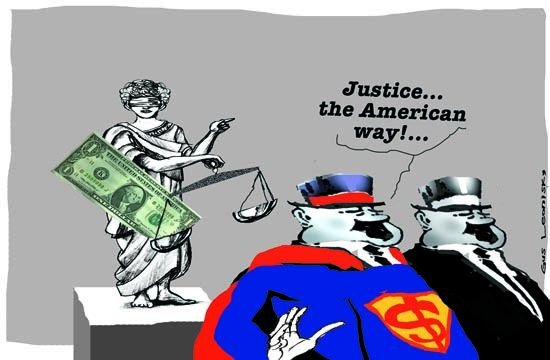Search
Recent comments
- intel failure....
42 sec ago - stealing oil...
3 hours 27 min ago - warmongers....
6 hours 51 min ago - stop lammy's murders....
7 hours 12 min ago - a piss president....
7 hours 19 min ago - not gone?.....
9 hours 50 min ago - stoopid kakka....
10 hours 34 min ago - last offer....
11 hours 6 min ago - overstaying.....
13 hours 8 min ago - quacks....
21 hours 22 min ago
Democracy Links
Member's Off-site Blogs
litigious investing ...

Putting Money on Lawsuits, Investors Share in the Payouts
By BINYAMIN APPELBAUM
Large banks, hedge funds and private investors hungry for new and lucrative opportunities are bankrolling other people’s lawsuits, pumping hundreds of millions of dollars into medical malpractice claims, divorce battles and class actions against corporations — all in the hope of sharing in the potential winnings.
The loans are propelling large and prominent cases. Lenders including Counsel Financial, a Buffalo company financed by Citigroup, provided $35 million for the lawsuits brought by ground zero workers that were settled tentatively in June for $712.5 million. The lenders earned about $11 million.
Most investments are in the smaller cases that fill court dockets. Ardec Funding, a New York lender backed by a hedge fund, lent $45,000 in June to a Manhattan lawyer hired by the parents of a baby brain-damaged at birth. The lawyer hired two doctors, a physical therapist and an economist to testify at a July trial. The jury awarded the baby $510,000. Ardec is collecting interest at an annual rate of 24 percent, or $900 a month, until the award is paid.
Total investments in lawsuits at any given time now exceed $1 billion, several industry participants estimated. Although no figures are available on lawsuits supported by lenders, public records from one state, New York, show that over the last decade, more than 250 law firms borrowed on pending cases, often repeatedly.
The rise of lending to plaintiffs and their lawyers is a result of the high cost of litigation. Pursuing a civil action in federal court costs an average of $15,000, the Federal Judicial Center reported last year. Cases involving scientific evidence, like medical malpractice claims, often cost more than $100,000. Some people cannot afford to pursue claims; others are overwhelmed by corporate defendants with deeper pockets.
A review by The New York Times and the Center for Public Integrity shows that the inflow of money is giving more people a day in court and arming them with well-paid experts and elaborate evidence. It is helping to ensure that cases are decided by merit rather than resources, echoing and expanding a shift a century ago when lawyers started fronting money for clients’ lawsuits.
http://www.nytimes.com/2010/11/15/business/15lawsuit.html?_r=1&hp=&pagewanted=print
- By Gus Leonisky at 15 Nov 2010 - 2:39pm
- Gus Leonisky's blog
- Login or register to post comments
justice on credit...
Total investments in lawsuits at any given time now exceed $1 billion, several industry participants estimated. Although no figures are available on the number of lawsuits supported by lenders, public records from one state, New York, show that over the last decade, more than 250 law firms borrowed on pending cases, often repeatedly.
The rise of lending to plaintiffs and their lawyers is a result of the high cost of litigation. Pursuing a civil action in federal court costs an average of $15,000, the Federal Judicial Center reported last year. Cases involving scientific evidence, like medical malpractice claims, often cost more than $100,000. Some people cannot afford to pursue claims; others are overwhelmed by corporate defendants with deeper pockets.
http://www.nytimes.com/2010/11/15/business/15lawsuit.html?hp=&pagewanted=all